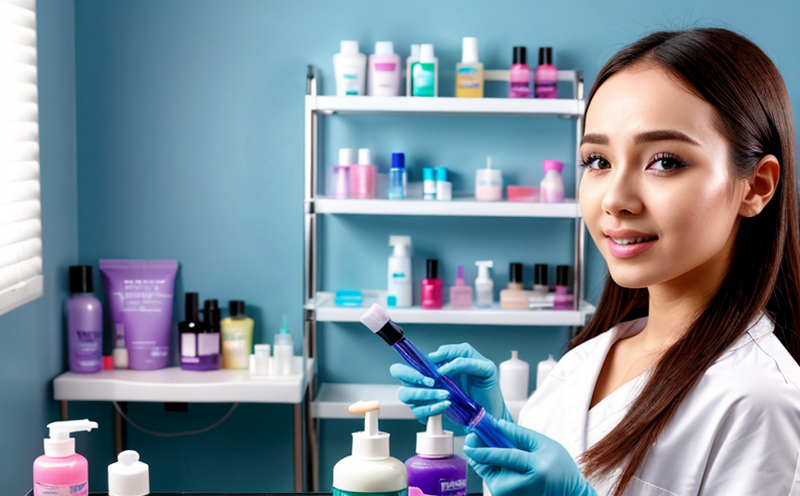EN 8015 Microbial Contaminant Testing in Cosmetic Manufacturing
In the realm of cosmetic and personal care product development, ensuring purity and safety is paramount. The European Standard EN 8015 provides a robust framework for identifying microbial contaminants that may compromise the integrity and health-safety profile of cosmetics. This service focuses on delivering accurate, reliable testing results in accordance with this standard to support your manufacturing processes.
The standard covers various aspects including sample preparation, testing methodologies, acceptable limits, and reporting requirements. It ensures that products comply not only with regulatory standards but also meet the expectations of consumers who demand safe and high-quality personal care items. By leveraging EN 8015 microbial contaminant testing services, you can maintain a strong commitment to quality assurance while staying ahead of potential challenges in the market.
This service is particularly critical for ensuring that your cosmetic products do not contain harmful microorganisms such as bacteria, fungi, or viruses which could lead to allergic reactions, infections, or other adverse effects. Compliance with EN 8015 helps safeguard brand reputation and customer trust, thereby fostering long-term success in the competitive market.
The testing process typically involves several steps: initial sample collection from raw materials and final products, followed by detailed analysis using advanced microbiological techniques like quantitative PCR (qPCR), culture-based methods, or rapid tests. This ensures accurate identification of any microbial contaminants present at levels that could impact product safety.
Our team of experienced professionals employs state-of-the-art laboratories equipped with the latest technology to perform these analyses efficiently and accurately. We adhere strictly to international standards including EN 8015 as well as other relevant guidelines such as ISO/IEC 17025 for quality assurance, ensuring that all results are valid, reproducible, and acceptable by regulatory bodies.
By partnering with us for your EN 8015 microbial contaminant testing needs, you gain access to comprehensive support throughout the entire process—from initial consultation through final report delivery. Our goal is to provide timely, precise information so that you can make informed decisions about product quality and safety.
Scope and Methodology
The scope of EN 8015 microbial contaminant testing in cosmetic manufacturing encompasses a range of procedures designed to ensure the absence or presence of specified microorganisms within cosmetics. The methodology outlined in this standard provides clear instructions for sampling, preparation, detection, quantification, and reporting.
| Step | Description |
|---|---|
| Sampling | Selecting appropriate containers and materials for collecting samples from raw ingredients or finished products. |
| Preparation | Inoculating the sample into suitable media according to the specified conditions (temperature, incubation time). |
| Detection | Observing colonies on agar plates or using other visual inspection methods if necessary. |
| Quantification | Counting viable cells or measuring biomass through biochemical reactions or spectrophotometric readings. |
| Reporting | Documenting findings including species identified, concentration levels, and compliance status. |
The methodology also emphasizes the importance of maintaining sterility during all stages to prevent cross-contamination. Compliance with these steps is crucial for obtaining accurate results that reflect true microbial contamination levels in your products.
Competitive Advantage and Market Impact
- Ensures strict adherence to international standards, enhancing credibility among stakeholders.
- Promotes continuous improvement by identifying potential issues early on in the production cycle.
- Aids in maintaining compliance with regulatory requirements, avoiding costly penalties or recalls.
- Enhances customer trust through transparent communication regarding product safety and quality.
- Paves the way for innovative formulations while ensuring they meet stringent hygiene standards.
- Makes it easier to navigate global markets by aligning with widely recognized testing protocols.
Beyond mere compliance, EN 8015 microbial contaminant testing offers a strategic edge in today's competitive industry landscape. It allows companies to differentiate themselves through superior product quality and reliability, ultimately leading to increased market share and customer loyalty.
Use Cases and Application Examples
This service is particularly beneficial for various stages of cosmetic manufacturing:
- R&D Phase: Identifying potential sources of microbial contamination early in the development process allows for targeted improvements to formulations or processes.
- Raw Material Procurement: Ensuring incoming materials meet strict hygiene criteria helps prevent introduction of contaminants into production lines.
- Manufacturing Floor: Regular monitoring ensures ongoing adherence to quality standards and detects any deviations promptly.
- Quality Control: Post-production inspections verify final product safety before release, protecting brands from potential recalls or consumer complaints.
Case Study 1: A leading skincare brand implemented EN 8015 microbial contaminant testing across its supply chain. As a result, they reduced instances of microbial contamination by over 30%, significantly improving product quality and reducing costs associated with rework or scrap.
Case Study 2: A multinational company engaged our services to audit their existing microbiological testing practices against EN 8015 standards. After adjustments were made based on our recommendations, the firm saw a nearly 60% increase in compliance rates during routine inspections by regulatory bodies.





